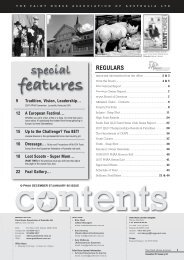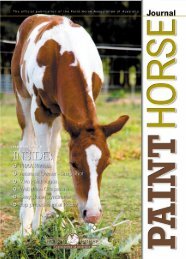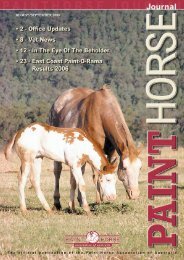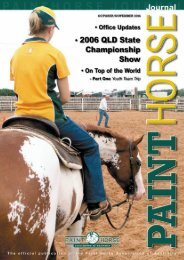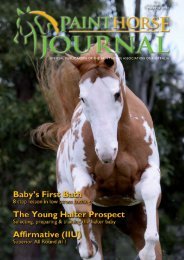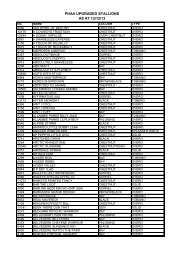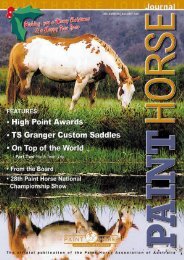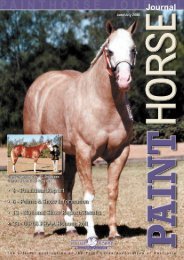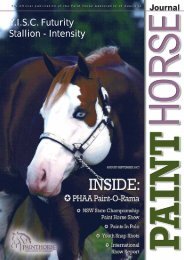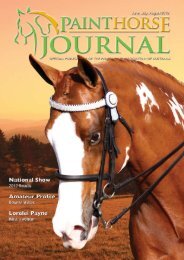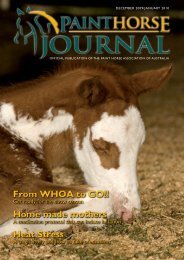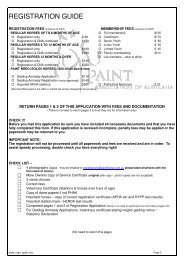Acres of Clover ⢠Photo by: Stefan & Barbara Wielebinski
Acres of Clover ⢠Photo by: Stefan & Barbara Wielebinski
Acres of Clover ⢠Photo by: Stefan & Barbara Wielebinski
Create successful ePaper yourself
Turn your PDF publications into a flip-book with our unique Google optimized e-Paper software.
● FEATURE<br />
ARTICLE: REBECCA OVERTON - AMERICAN PAINT HORSE JOURNAL<br />
- HTTP://WWW.APHA.COM/<br />
PHOTOS BY: DARRELL DODDS<br />
Roan horses are eye-catchers, but their<br />
distinctive colour can be confusing.<br />
Just because a horse has white hair<br />
mixed with another colour, you can’t<br />
automatically assume it’s a raon.<br />
yYOU might call The Presidents Hat a genetic impossibility.<br />
At least that’s what the gelding was when the American<br />
Paint Horse Association registered him in 1998.<br />
Sired <strong>by</strong> the famous Paint stallion Sacred Indian and out <strong>of</strong><br />
Continetta (AQHA), The Presidents Hat was registered as<br />
a red roan tobiano. But he couldn’t be a red roan.<br />
Genetically, it couldn’t happen. Although Continetta is a red<br />
roan, Sacred Indian is a bay tovero. Not just any bay tovero,<br />
however. Sacred Indian is homozygous for the black and<br />
tobiano genes. “Because he’s homozygous for black, he<br />
can’t produce anything that doesn’t have black points,”<br />
explained Karen Banister <strong>of</strong> White Harvest Farms in<br />
Brighton, Colorado. Banister’s daughter, Elizabeth, owns<br />
Sacred Indian, and her niece, Ashleigh Dechant, owns The<br />
Presidents Hat. “If you breed him to a red roan mare, his<br />
get will always be bay roans.”<br />
This is because the bay gene is dominant to the red gene.<br />
Sacred Consuela, a full sister to The Presidents Hat, is also<br />
registered as a red roan, but, like her brother, she is a bay<br />
roan, as well. APHA listed both horses as red roans<br />
because at the time they were registered the association<br />
did not recognize bay roan as an approved color. The<br />
horses more closely resembled red roan than blue roan, the<br />
other roan color on APHA’s list <strong>of</strong> approved hues, and so<br />
were given that designation. Roan, a horse coat color<br />
traditionally favored <strong>by</strong> cowboys, is distinctive, but it can be<br />
misleading. Just because a horse has white hair mixed in<br />
with a base coat <strong>of</strong> another color doesn’t automatically<br />
make it a roan.<br />
In 1999, APHA added bay roan to its list in an attempt to<br />
identify coat color as accurately as possible. “We want to be<br />
as genetically correct as we can,” APHA Registrar Cindy<br />
Grier said. “Sometimes it’s not possible to go back and<br />
correct the old records, so we’re trying to make sure the<br />
ones we do now are as complete and correct as possible.<br />
In a case like The Presidents Hat, we’ll do corrections to<br />
our certificates at no charge.” By October 30, 2001, out <strong>of</strong><br />
639,923 horses in APHA’s Regular Registry, 17,079 were<br />
red roans, 3,786 were blue roans and 479 were bay roans.<br />
“There are probably a lot <strong>of</strong> bay roans in those red roan<br />
numbers,” said Grier. APHA verifies a horse’s parentage <strong>by</strong><br />
looking at photographs <strong>of</strong> its sire and dam to see their color.<br />
“We also use get and produce records to see if a horse has<br />
produced any other roan foals out <strong>of</strong> a nonroan parent,”<br />
The<br />
white<br />
stuff<br />
Grier noted. Sometimes it can take a bit <strong>of</strong> detective work<br />
to determine if a horse is really a roan.<br />
NAME GAME<br />
In the world <strong>of</strong> equine genetics, experts readily<br />
acknowledge the roan pattern is one <strong>of</strong> the most eyecatching—and<br />
confusing. One <strong>of</strong> the reasons identifying<br />
roan can be so challenging is because the term is used in<br />
two different ways to describe coat color, explained Dr.<br />
Phillip Sponenberg, pr<strong>of</strong>essor <strong>of</strong> pathology and genetics at<br />
the Virginia-Maryland Regional College <strong>of</strong> Veterinary<br />
Medicine.<br />
“Roan is a general term used for the intermixture <strong>of</strong> white<br />
hairs and colored hairs in all animals,” Sponenberg writes<br />
in his book Equine Color Genetics. “In that general sense,<br />
all <strong>of</strong> the patterns on horses that arise from such an<br />
intermixture could be called roan. . . .<br />
The Paint Horse Journal 27<br />
April/May 2008



